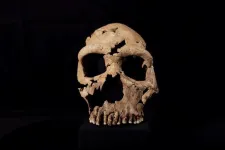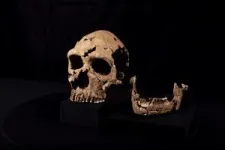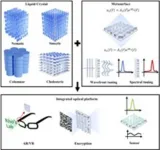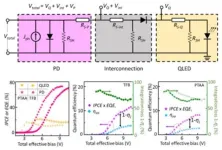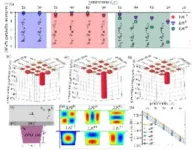(Press-News.org) A new Netflix documentary has recreated the face of a 75,000-year-old female Neanderthal whose flattened skull was discovered and rebuilt from hundreds of bone fragments by a team of archaeologists and conservators led by the University of Cambridge.
The team excavated the female Neanderthal in 2018 from inside a cave in Iraqi Kurdistan where the species had repeatedly returned to lay their dead to rest. The cave was made famous by work in the late 1950s that unearthed several Neanderthals which appeared to have been buried in succession.
‘Secrets of the Neanderthals’, produced by BBC Studios Science Unit, is released on Netflix worldwide. The documentary follows the team led by the universities of Cambridge and Liverpool John Moores as they return to Shanidar Cave to continue excavations.
“The skulls of Neanderthals and humans look very different,” said Dr Emma Pomeroy, a palaeo-anthropologist from Cambridge’s Department of Archaeology, who features in the new film.
“Neanderthal skulls have huge brow ridges and lack chins, with a projecting midface that results in more prominent noses. But the recreated face suggests those differences were not so stark in life.
“It’s perhaps easier to see how interbreeding occurred between our species, to the extent that almost everyone alive today still has Neanderthal DNA.”
Neanderthals are thought to have died out around 40,000 years ago, and the discoveries of new remains are few and far between. The Neanderthal featured in the documentary is the first from the cave for over fifty years, and perhaps the best preserved individual to be found this century.
While earlier finds were numbered, this one is called Shanidar Z, although researchers think it may be the top half of an individual excavated in 1960.
The head had been crushed, possibly by rockfall, relatively soon after death – after the brain decomposed but before the cranium filled with dirt – and then compacted further by tens of thousands of years of sediment.
When archaeologists found it, the skull was flattened to around two centimetres thick.
The team carefully exposed the remains, including an articulated skeleton almost to the waist, and used a glue-like consolidant to strengthen the bones and surrounding sediment. They removed Shanidar Z in dozens of small foil-wrapped blocks from under seven and a half metres of soil and rock within the heart of the cave.
In the Cambridge lab, researchers took micro-CT scans of each block before gradually diluting the glue and using the scans to guide extraction of bone fragments. Lead conservator Dr Lucía López-Polín pieced over 200 bits of skull together freehand to return it to its original shape, including upper and lower jaws.
“Each skull fragment is gently cleaned while glue and consolidant are re-added to stabilise the bone, which can be very soft, similar in consistency to a biscuit dunked in tea,” said Pomeroy. “It’s like a high stakes 3D jigsaw puzzle. A single block can take over a fortnight to process.”
The team even referred to forensic science – studies on how bones shift after blunt force trauma and during decomposition – to help them understand if remains had been buried, and the ways in which teeth had pinged from jawbones.
The rebuilt skull was surface scanned and 3D-printed, forming the basis of a reconstructed head created by world-leading palaeoartists and identical twins Adrie and Alfons Kennis, who built up layers of fabricated muscle and skin to reveal a face.
New analysis strongly suggests that Shanidar Z was an older female, perhaps in her mid-forties according to researchers – a significant age to reach so deep in prehistory.
Without pelvic bones, the team relied on sequencing tooth enamel proteins to determine her sex. Teeth were also used to gauge her age through levels of wear and tear – with some front teeth worn down to the root. At around five feet tall, and with some of the smallest adult arm bones in the Neanderthal fossil record, her physique also implies a female.
While remnants of at least ten separate Neanderthals have now come from the cave, Shanidar Z is the fifth to be found in a cluster of bodies buried at a similar time in the same location: right behind a huge vertical rock, over two metres tall at the time, which sits in the centre of the cave.
The rock had come down from the ceiling long before the bodies were interred. Researchers say it may have served as a landmark for Neanderthals to identify a particular site for repeated burials.
“Neanderthals have had a bad press ever since the first ones were found over 150 years ago,” said Professor Graeme Barker from Cambridge’s McDonald Institute for Archaeological Research, who leads the excavations at the cave.
“Our discoveries show that the Shanidar Neanderthals may have been thinking about death and its aftermath in ways not so very different from their closest evolutionary cousins – ourselves.”
The other four bodies in the cluster were discovered by archaeologist Ralph Solecki in 1960. One was surrounded by clumps of ancient pollen. Solecki and pollen specialist Arlette Leroi-Gourhan argued the finds were evidence of funerary rituals where the deceased was laid to rest on a bed of flowers.
This archaeological work was among the first to suggest Neanderthals were far more sophisticated than the primitive creatures many had assumed, based on their stocky frames and ape-like brows.
Decades later, the Cambridge-led team retraced Solecki’s dig, aiming to use the latest techniques to retrieve more evidence for his contentious claims, as well as the environment and activities of the Neanderthals and later modern humans who lived there, when they uncovered Shanidar Z.
“Shanidar Cave was used first by Neanderthals and then by our own species, so it provides an ideal laboratory to tackle one of the biggest questions of human evolution,” said Barker.
“Why did Neanderthals disappear from the stage around the same time as Homo sapiens spread over regions where Neanderthals had lived successfully for almost half a million years?”
A study led by Professor Chris Hunt of Liverpool John Moores University now suggests the pollen was left by bees burrowing into the cave floor. However, remains from Shanidar Cave still show signs of an empathetic species. For example, one male had a paralysed arm, deafness and head trauma that likely rendered him partially blind, yet had lived a long time, so must have been cared for.
Site analysis suggests that Shanidar Z was laid to rest in a gully formed by running water that had been further hollowed out by hand to accommodate the body. Posture indicates she had been leant against the side, with her left hand curled under her head, and a rock behind the head like a small cushion, which may have been placed there.
While Shanidar Z was buried within a similar timeframe as other bodies in the cluster, researchers cannot say how contemporaneous they are, only that they all date to around 75,000 years ago.
In fact, while filming onsite for the new documentary in 2022, the team found remains of yet another individual in the same burial cluster, uncovering the left shoulder blade, some ribs and a fairly complete right hand.
In the sediments several feet above, another three Neanderthals dating to around 50,000 years had been found by Solecki, more of which have been recovered by the current team.
Further research since Shanidar Z was found has detected microscopic traces of charred food in the soil around the older body cluster. These carbonised bits of wild seeds, nuts and grasses, suggest not only that Neanderthals prepared food – soaking and pounding pulses – and then cooked it, but did so in the presence of their dead.
“The body of Shanidar Z was within arm’s reach of living individuals cooking with fire and eating,” said Pomeroy. “For these Neanderthals, there does not appear to be that clear separation between life and death.”
“We can see that Neanderthals are coming back to one particular spot to bury their dead. This could be decades or even thousands of years apart. Is it just a coincidence, or is it intentional, and if so what brings them back?”
“As an older female, Shanidar Z would have been a repository of knowledge for her group, and here we are seventy-five thousand years later, learning from her still,” Pomeroy said.
END
Revealed: face of 75,000-year-old female Neanderthal from cave where species buried their dead
2024-05-02
ELSE PRESS RELEASES FROM THIS DATE:
Hepatitis B is globally underassessed and undertreated, especially among women and Asian minorities in the West
2024-05-02
Amsterdam, May 2, 2024 – New evidence reveals global underassessment and undertreatment of chronic hepatitis B (HBV), especially among women and Asian minorities in the West, a new study in the Journal of Hepatology, published by Elsevier, details.
"In clinical practice we continue to see patients with advanced liver disease due to HBV despite having vaccines for prevention and excellent oral therapy for those who are treatment eligible. Simplifying and broadening HBV management is crucial," according to the researchers.
With the World Health Organization's goal to eliminate viral hepatitis by 2030 fast approaching, targeted outreach is needed to reduce new infections ...
Efficient stochastic parallel gradient descent training for on-chip optical processors
2024-05-01
A new publication from Opto-Electronic Advances; DOI 10.29026/oea.2024.230182 , discusses efficient stochastic parallel gradient descent training for on-chip optical processors.
With the explosive growth of global data volume, space-division multiplexing (SDM) technology has been emerged as a promising solution to enhance the communication capacity. Over the past few decades, SDM has been realized in few-mode fibers, multi-core fiber and free-space optical communication systems. However, all of above solutions face challenges of signal crosstalk because of the mixing between different channels during the ...
Liquid crystal-integrated metasurfaces for an active photonic platform
2024-05-01
A new publication from Opto-Electronic Advances; DOI 10.29026/oea.2024.230216 , discusses liquid crystal-integrated metasurfaces for an active photonic platform.
In the field of optical science, the exploration of metasurfaces has garnered significant attention over the last few decades. Metasurfaces represent a sophisticated evolution of traditional optical components, comprising nanostructures meticulously arranged to enable precise control over light manipulation. These nanostructures function as building blocks, allowing for the creation of lenses with unique ...
Unraveling the efficiency losses and improving methods in quantum dot-based infrared up-conversion photodetectors
2024-05-01
A new publication from Opto-Electronic Science; DOI 10.29026/oes.2024.230029 discusses unraveling the efficiency losses and improving methods in quantum dot-based infrared up-conversion photodetectors.
Traditional infrared imagers are usually constructed by bonding an infrared PD with each pixel of a thin film transistor (TFT)-based active-matrix backplane. A feasible way to avoid the costly pixilation is to use infrared up-conversion photodetector, in which an infrared photodetector (PD) and a light-emitting diode (LED) with large effective areas are back-to-back ...
A novel deep proteomic approach unveils molecular signatures affected by aging and resistance training
2024-05-01
“Resistance training can reverse certain aspects of skeletal muscle aging.”
BUFFALO, NY- May 1, 2024 – A new research paper was published in Aging (listed by MEDLINE/PubMed as "Aging (Albany NY)" and "Aging-US" by Web of Science) Volume 16, Issue 8, entitled, “A novel deep proteomic approach in human skeletal muscle unveils distinct molecular signatures affected by aging and resistance training.”
The skeletal muscle proteome alterations to aging and resistance training have been reported in prior studies. However, ...
High-intensity spatial-mode steerable frequency up-converter toward on-chip integration
2024-05-01
A new publication from Opto-Electronic Science; DOI 10.29026/oes.2024.230036 discusses high-intensity spatial-mode steerable frequency up-converter toward on-chip integration.
Integrated photonic devices consisting of micro-lasers, amplifiers, optical waveguides, frequency converters, and modulators on a single chip, enabling control over photon's spatial modes, frequencies, angular momenta, and phases, are essential for preparing high-dimensional quantum entangled states, high-capacity photon information processing, all-optical communication, and miniaturization of photonic computing. However, ...
Study indicates that cancer patients gain important benefits from genome-matched treatments
2024-05-01
In 2016, The Jackson Laboratory (JAX), a National Cancer Institute-designated Cancer Center and at the forefront of cancer research, launched the Maine Cancer Genomics Initiative (MCGI) to bring the latest progress in cancer care to rural Maine patients. Now, after successfully expanding access to genome tumor testing and targeted cancer treatments throughout Maine, the MCGI team provides compelling evidence that genome-matched treatments can provide significant patient benefit.
The MCGI report, published recently in npj Precision Oncology, ...
Gift to UCR clinic aims to assist local unhoused population
2024-05-01
RIVERSIDE, Calif. -- The Hulen Place Clinic, which UCR Health, the clinical arm of the School of Medicine (SOM) at the University of California, Riverside, opened in September 2023 to address the health and well-being of the unhoused and underserved populations in the County of Riverside has received a gift of $500,000 from the San Manuel Band of Mission Indians, a sovereign American Indian tribe of Serrano people in San Bernardino County, California.
Located about two miles from downtown Riverside and adjacent to an emergency shelter and temporary ...
Research breakthrough on birth defect affecting brain size
2024-05-01
RIVERSIDE, Calif. -- Nonsense-mediated RNA decay, or NMD, is an evolutionarily conserved molecular mechanism in which potentially defective messenger RNAs, or mRNAs (genetic material that instructs the body on how to make proteins), are degraded. Disruption of the NMD pathway can lead to neurological disorders, immune diseases, cancers, and other pathologies. Mutations in human NMD regulators are seen in neurodevelopmental disorders, including autism and intellectual disability.
Why NMD mutations are enriched ...
Researchers offer US roadmap to close the carbon cycle
2024-05-01
Scientists at Oak Ridge National Laboratory and six other Department of Energy national laboratories have developed a United States-based perspective for achieving net-zero carbon emissions. The roadmap was recently published in the journal Nature Reviews Chemistry.
The researchers from the DOE laboratories — ORNL, Pacific Northwest National Laboratory, Brookhaven National Laboratory, Argonne National Laboratory, Lawrence Berkeley National Laboratory, Ames National Laboratory and SLAC National Accelerator Laboratory — pooled their diverse expertise to devise a roadmap to “defossilize” portions of the U.S. economy by reducing carbon emissions ...
